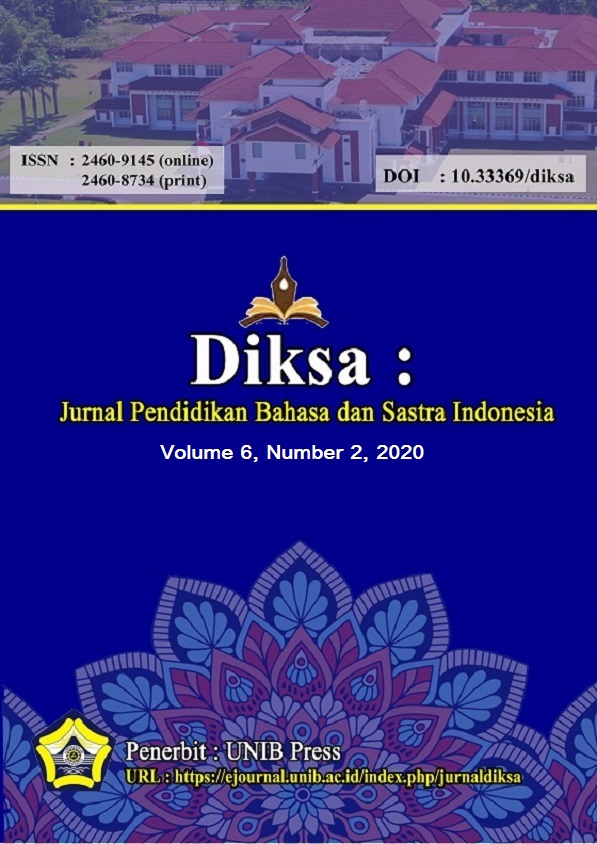Main Article Content
Abstract
Keywords
Article Details
Authors who publish with this journal agree to the following terms:
- Authors retain copyright and grant the journal right of first publication with the work simultaneously licensed under a Creative Commons Attribution License that allows others to share the work with an acknowledgment of the work's authorship and initial publication in this journal.
- Authors are able to enter into separate, additional contractual arrangements for the non-exclusive distribution of the journal's published version of the work (e.g., post it to an institutional repository or publish it in a book), with an acknowledgment of its initial publication in this journal.
- Authors are permitted and encouraged to post their work online (e.g., in institutional repositories or on their website) prior to and during the submission process, as it can lead to productive exchanges, as well as earlier and greater citation of published work (See The Effect of Open Access).
References
- Agustina, R. (2016). Aspek Leksikal dan Gramatikal Pada Lirik Lagu Jika Karya Melly Goeslow. BAHASTRA, 36(1), 97. doi:10.26555/bahastra.v36i1.5061
- Astiti, M. S., Wardarita, R., & Fitriani, Y. (2020). The Preservation of Balinese Spoken Language at the Ngaben and Potong Gigi Event. Jadila: Journal of Development and Innovation in Language and Literature Education, 1(2), 139-149. Retrieved from https://ejournal.karinosseff.org/index.php/jadila/article/view/42
- Dedi, D., & Cekman, C. (2018). Kohesi Leksikal dalam Acara Berasan Masyarakat Sindang Kelingi Musi Rawas. Silampari Bisa: Jurnal Penelitian Pendidikan Bahasa Indonesia, Daerah, dan Asing, 1(1), 66–83. doi:10.31540/silamparibisa.v1i1.15
- Keraf, G. (1997). Komposisi. Flores: Nusa Indah.
- Kridalaksana, H. (1984). Kamus Linguistik. Jakarta: Gramedia.
- Kusmiarti, R., Yuniati, I., & Noermanzah. (2020). Improving Student Communication Skills In Learning Indonesian Language Through Collaborative Learning. Retrieved from osf.io/9km3u. International Journal of Scientific and Technology Research, 9(1).
- Muzakka, M. (2020). Nilai-Nilai Profetik dalam Dua Lirik Lagu Karya Rhoma Irama Kajian terhadap Lirik Lagu “Akhlak” dan “Virus Corona.” Nusa: Jurnal Ilmu Bahasa dan Sastra, 15(1), 13–22. doi:10.14710/nusa.15.1.13-22
- Noermanzah, N. (2019). Bahasa sebagai Alat Komunikasi, Citra Pikiran, dan Kepribadian. Seminar Nasional Pendidikan Bahasa dan Sastra, Prosiding Seminar Nasional Bulan Bahasa (Semiba), 307, https://ejournal.unib.ac.id/index.php/semiba/article/view/11151/5537
- Noermanzah, N. (2020). Pemilihan Perangkat Retorika pada Pidato Presiden Republik Indonesia dalam Mempromosikan Kebijakan Pemerintah dalam Bidang Pendidikan. Diglosia: Jurnal Pendidikan, Kebahasaan, dan Kesusastraan Indonesia, 4(2). http://jurnal.unma.ac.id/index.php/dl/article/view/2351
- Oktafianus. (2006). Analisis Wacana Lintas Bahasa. Padang: Andalas University Press.
- Sari, I. P., & Setyorini, R. (2018). Aspek Gramatikal dan Leksikal Pada Lirik Lagu “Aku Cinta Allah” Group Band Wali. SeBaSa, 1(2), 129. doi:10.29408/sbs.v1i2.1040
- Sinambela, K., Simanjuntak, T., & Telaumbanua, S. (2019). Aspek Kohesi Gramatikal dan Leksikal pada Karangan Eksposisi Kelas X SMA Negeri 1 Laguboti Kabupaten Toba Samosir T.A 20182019. Jurnal Genre (Bahasa, Sastra, dan Pembelajarannya), 1(1), 9. doi:10.26555/jg.v1i1.1054
- Sulaksono, D. (2019). Analisis Aspek Gramatikal dan Leksikal Iklan Kecik dalam Surat Kabar Solopos. JISABDA: Jurnal Ilmiah Sastra dan Bahasa Daerah, serta Pengajarannya, 1(2), 13. doi:10.26877/jisabda.v1i2.4740
- Sumarlam. Ed. (2008). Teori dan Praktik Analisis Wacana. Surakarta: Pustaka Cakra.
- Widayati, S. (2018). Analisis Wacana Cerpen “Tinggal Matanya Berkedip-kedip” Karya Ahmad Tinjauan Aspek Sosial Budaya serta Penanda Kohesi Gramatikal dan Leksikal. Edukasi Lingua Sastra, 15(2), 73–88. doi:10.47637/elsa.v15i2.69
- Wijayanti, S. H. (2015). Ketaksaan Gramatikal dan Leksikal dalam Bahasa Indonesia. Diksi, 10(2). doi:10.21831/diksi.v10i2.6966
References
Agustina, R. (2016). Aspek Leksikal dan Gramatikal Pada Lirik Lagu Jika Karya Melly Goeslow. BAHASTRA, 36(1), 97. doi:10.26555/bahastra.v36i1.5061
Astiti, M. S., Wardarita, R., & Fitriani, Y. (2020). The Preservation of Balinese Spoken Language at the Ngaben and Potong Gigi Event. Jadila: Journal of Development and Innovation in Language and Literature Education, 1(2), 139-149. Retrieved from https://ejournal.karinosseff.org/index.php/jadila/article/view/42
Dedi, D., & Cekman, C. (2018). Kohesi Leksikal dalam Acara Berasan Masyarakat Sindang Kelingi Musi Rawas. Silampari Bisa: Jurnal Penelitian Pendidikan Bahasa Indonesia, Daerah, dan Asing, 1(1), 66–83. doi:10.31540/silamparibisa.v1i1.15
Keraf, G. (1997). Komposisi. Flores: Nusa Indah.
Kridalaksana, H. (1984). Kamus Linguistik. Jakarta: Gramedia.
Kusmiarti, R., Yuniati, I., & Noermanzah. (2020). Improving Student Communication Skills In Learning Indonesian Language Through Collaborative Learning. Retrieved from osf.io/9km3u. International Journal of Scientific and Technology Research, 9(1).
Muzakka, M. (2020). Nilai-Nilai Profetik dalam Dua Lirik Lagu Karya Rhoma Irama Kajian terhadap Lirik Lagu “Akhlak” dan “Virus Corona.” Nusa: Jurnal Ilmu Bahasa dan Sastra, 15(1), 13–22. doi:10.14710/nusa.15.1.13-22
Noermanzah, N. (2019). Bahasa sebagai Alat Komunikasi, Citra Pikiran, dan Kepribadian. Seminar Nasional Pendidikan Bahasa dan Sastra, Prosiding Seminar Nasional Bulan Bahasa (Semiba), 307, https://ejournal.unib.ac.id/index.php/semiba/article/view/11151/5537
Noermanzah, N. (2020). Pemilihan Perangkat Retorika pada Pidato Presiden Republik Indonesia dalam Mempromosikan Kebijakan Pemerintah dalam Bidang Pendidikan. Diglosia: Jurnal Pendidikan, Kebahasaan, dan Kesusastraan Indonesia, 4(2). http://jurnal.unma.ac.id/index.php/dl/article/view/2351
Oktafianus. (2006). Analisis Wacana Lintas Bahasa. Padang: Andalas University Press.
Sari, I. P., & Setyorini, R. (2018). Aspek Gramatikal dan Leksikal Pada Lirik Lagu “Aku Cinta Allah” Group Band Wali. SeBaSa, 1(2), 129. doi:10.29408/sbs.v1i2.1040
Sinambela, K., Simanjuntak, T., & Telaumbanua, S. (2019). Aspek Kohesi Gramatikal dan Leksikal pada Karangan Eksposisi Kelas X SMA Negeri 1 Laguboti Kabupaten Toba Samosir T.A 20182019. Jurnal Genre (Bahasa, Sastra, dan Pembelajarannya), 1(1), 9. doi:10.26555/jg.v1i1.1054
Sulaksono, D. (2019). Analisis Aspek Gramatikal dan Leksikal Iklan Kecik dalam Surat Kabar Solopos. JISABDA: Jurnal Ilmiah Sastra dan Bahasa Daerah, serta Pengajarannya, 1(2), 13. doi:10.26877/jisabda.v1i2.4740
Sumarlam. Ed. (2008). Teori dan Praktik Analisis Wacana. Surakarta: Pustaka Cakra.
Widayati, S. (2018). Analisis Wacana Cerpen “Tinggal Matanya Berkedip-kedip” Karya Ahmad Tinjauan Aspek Sosial Budaya serta Penanda Kohesi Gramatikal dan Leksikal. Edukasi Lingua Sastra, 15(2), 73–88. doi:10.47637/elsa.v15i2.69
Wijayanti, S. H. (2015). Ketaksaan Gramatikal dan Leksikal dalam Bahasa Indonesia. Diksi, 10(2). doi:10.21831/diksi.v10i2.6966
